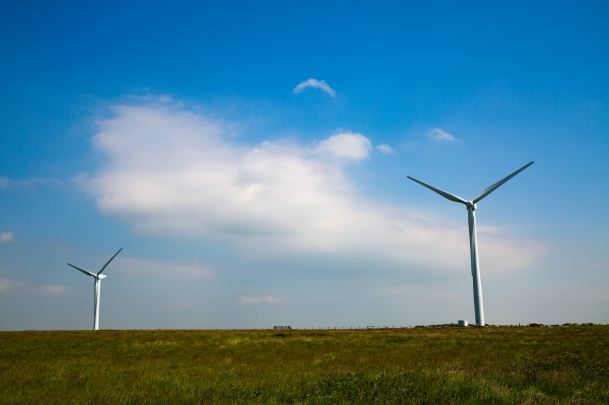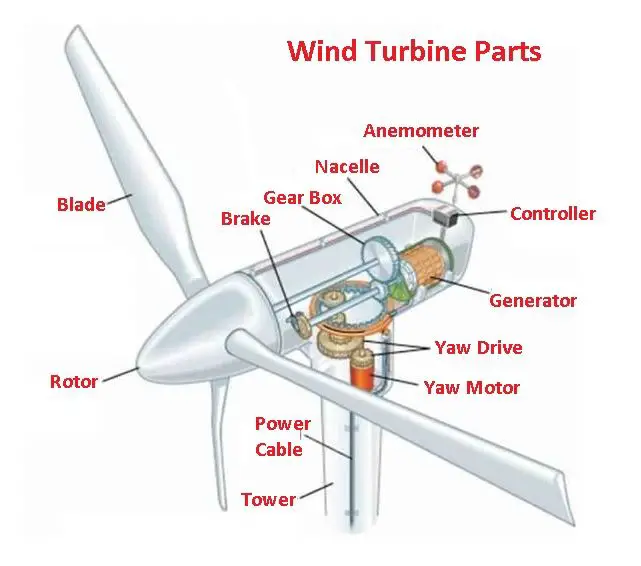In this post, you will learn about the wind power plant and its diagram, working, the importance of wind energy, advantages, application and more.
Also, you can download the PDF file at the end of this article.
What is Wind Power Plant?
The wind is the natural circulation of air across the land or sea. The wind is caused by uneven heating and cooling of the earth’s surface and by the earth’s rotation. Land and areas absorb and release a different amount of heat received from the sun
As the warmth rises, cooler air rushes in to take its place, causing winds. The rotation of the earth changes the direction of the flow of air. Wind energy is the kinetic energy of the motion of a large mass of air on the surface of the Earth, which is produced by the non-uniform heat of the Earth’s surface by the Sun.

The air above the ground gets heated and expanded by the solar heat which is pushed upward by cool dense air causing the wind. This process depends on the nature of the region, the degree of cloud cover, and the angle of the sun in the sky. The wind speed increases with the height which controls enough kinetic energy, this energy is used to rotate the wind turbine called a windmill.
Wind power, as an alternative to burning fossil fuels, is plentiful, clean, widely distributed, renewable, produces no greenhouse gas emissions while operating, has no water intake, and uses little land. The net effect on the environment is far less problematic than those of non-renewable power sources. Wind farms have wind turbines of many individuals connected to an electric power transmission network.
Read also:
- Power Plant: Types, Factors, Choices and Terminology Used in Power Plant
- What is Power Plant Economics? It’s Cost of Power Generation and Calculation
Definition of Wind Power Plant
Wind energy is a natural form of energy that is capable of producing electrical or mechanical forces. Windmills or wind turbines are devices that are capable of converting the kinetic energy of wind into mechanical energy. This mechanical energy is further converted into electrical energy.
Now let’s discuss the importance of a wind power plant.
Importance of Wind Energy
The following are the important features of Wind Energy:
- Wind energy is environment-friendly.
- The cheapest source of electrical energy.
- A project of wind energy is the fastest payback period.
- Operation and maintenance costs are low.
- A wind energy project is no investment in manpower.
- A wind energy project is a fast-track power project with a lower gestation (reproductive cycle) period and a modular concept.
- The cost per kWh reduces over a period of time as against rising conventional power projects.
- Wind energy is plentiful throughout the world.
- During the production of this energy, no pollution of air or water occurs.
- Necessary machines for harnessing this power are available economically.
We are going to discuss the most essential parts of wind turbine.
You might like: Different Types of Evaporators & Their Working [PDF]
Parts of Wind Turbine
Following are the different parts of the wind turbine:
- Blades
- The rotor
- Nacelle
- A gearbox and coupling (transmission system)
- Aero turbine
- Controller
- Electrical generator
- Supporting structure.

#1 Blade
Lifting-style wind turbine blades. These are designed most efficiently, especially to capture the energy of strong, fast winds. Some European companies actually manufacture single-blade turbines.
#2 The Rotor
The rotor is aerodynamically designed to occupy the maximum surface area of the wind to spin the most ergonomically. The blades are lightweight, durable, and corrosion-resistant material. The best materials are composites of fiberglass and reinforced plastic.
#3 Nacelle
A housing that contains all the components which are essential to operate the turbine efficiently is called a nacelle. It is mounted on top of a tower and includes gearboxes, generators, low and high-speed shafts, controllers, and brakes.
The nacelle is fitted with a wind speed anemometer and a wind vane. Nacelle provides housing for:
- Low-speed shaft
- Brake
- Gearbox
- High-speed shaft
- Generator
- Anemometer
- Wind vane.
#4 A Gearbox and Coupling (Transmission System)
A gearbox magnifies or amplifies the energy output of the rotor. The gearbox is located directly between the rotor and the generator. A rotor rotates the generator as directed by the tail vane.
#5 Aeroturbine
Aeroturbine converts wind energy into rotary mechanical energy.
#6 Controller
The controller realizes the wind direction wind speed output of the generator rotor and other required performance quantities of the system and initiates appropriate control signals to take appropriate corrective action.
#7 Electrical Generator
This unit produces electricity from the rotation of the rotor. The generator comes in various sizes with respect to the output. This generator converts mechanical energy into electrical power. The output of the generator is coupled to the load or system grid.
#8 Supporting Structure
This is the heavy structure set up with a proper foundation and carries all the components of the windmill. It should be properly designed with a proper factor of safety to withstand a dead load of all components and wind force.
You might like: Understand The Different Types of Condensers
Working of Wind Power Plant
The wind turbines or wind generators use the power of the wind which they turn into electricity. The speed of the wind turns the blades of a rotor (between 10 and 25 turns per minute), a source of mechanical energy. The rotor then turns on a generator that converts mechanical energy into electricity.
As the wind blows, a wind turbine converts the kinetic energy of the wind’s motion into mechanical energy by the rotation of the rotor, and this mechanical energy is transmitted by the shaft to the generator through the gear train. The generator converts this mechanical energy into electrical energy, thereby generating electricity.
An electric motor orientates the nacelle so that its rotor is placed facing the wind. Each turbine is made up of a mast between 20 m and 100 m according to the power of the machines. The mast supports the rotor usually equipped with three blades, and the nacelle which contains the generator with electrical and mechanical backup.
Wind turbines are designed for wind speeds of between 14 and 90 km/hour. Above that, the braking mechanism automatically stops the turbine for the safety of the equipment and to minimize wear and tear. Modern wind turbines supply their normal power at around 50 km/h.
A wind turbine is connected to the electricity network via a transformer located at the base of the mast. The electricity produced is generally stepped up to the voltage of the network (20 kV), then it passes through a delivery substation before being fed into the distribution or electrical transport network.
You might like: How Does A Air Conditioning System Work?
Factors Affecting the Distribution of Wind Energy
The power output of the wind turbines can be increased by turning the head in such a way that the blades face the wind, this can be done with a wind direction sensor connected with a motorized head moving mechanism (or yaw).
The following are some factors that affect the distribution of wind energy:
- Wind speed.
- Good road access to the site.
- Suitable region and geology for onsite access.
- Low pollution density.
- Minimum risk of agroforestry operations.
- Nearness to the electrical grid.
- Supportive landholders.
- Privately owned freehold land.
- Good industrial support for construction and ongoing operation.
- High annual average wind speed.
- Height of the windmill.
- The altitude of the site.
- A smooth steady wind speed that should blow all the time.
- Government policy.
- Demand for electricity.
- Icing problems, salt spray, or blowing dust should be present at the site.
- Blade aerodynamics.
- Obstructions
- Air temperature.
- Performance of wind turbine.
You might like: Different Types of Furnaces and Their Applications
Applications of Wind Power
The following are the applications of wind energy:
- It is used for pumping water.
- It is used for generating electricity.
- Used for running the floor mill.
- It is used to lift the water for irrigation purposes.
- It is used for milling and grinding applications.
Advantages of Wind Energy or Wind Power Plant
The following are the advantages of wind power plants:
- Wind energy is a renewable energy source.
- It does not require any fuel and avoids transportation.
- Being free from pollution helps in maintaining ecological balance.
- It is very economical and competitive.
- High-altitude areas which are isolated from public use can be utilized for setting the windmill.
- A small plot of land is required.
- It does not require water.
- Free from risks associated with volatile fossil fuel.
Disadvantages of Wind Power Plant
The following are the disadvantages of wind power plant:
- Continuous power generation is not possible due to fluctuation
- Noisy is in operation during the conversion of energy.
- It requires a larger area.
- It needs high storage capacity due to its irregularity.
- Wind energy systems have a high overall weight
- These systems require proper maintenance.
Conclusion
That’s it. Thanks for reading. I hope I have covered everything about the “Wind Power Plant Working.” It would be helpful if you could let me know if there was anything I missed or if you have any doubts about anything I wrote.
Please share this article with your friends if you find it interesting.
Want free PDFs direct to your inbox? Then subscribe to our newsletter.
You might like to read more about power plants in our blog:
- How Does A Gas Turbine Power Plant Work?
- Understand The Working Principle of Solar Power Plant
- Everything You Need Know About The Diesel Power Plant
External Links: